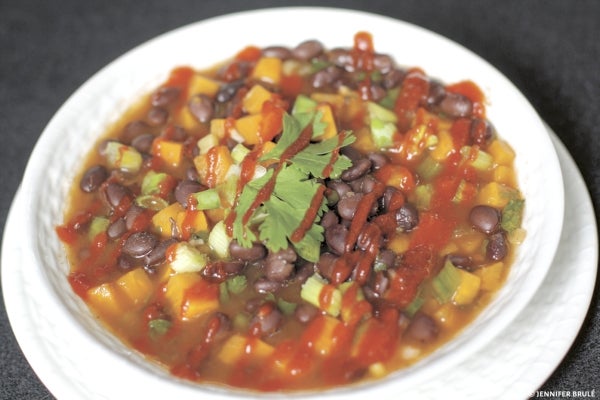Learn the classic, lighten it up and turn it around
Published 12:00 am Tuesday, September 13, 2016

- University of North Carolina Press Black Bean Stew with Sweet Potato and Ginger from 'Learn to Cook 25 Southern Classics 3 Ways," by Jennifer Brulé.
By Deirdre Parker Smith
deirdre.smith@salisburypost.com
SALISBURY — Leave it to UNC Press to come up with another tantalizing cookbook — who knew a scholarly publisher would be so good at producing quality cookbooks such as the Savor the South series.
This time, Jennifer Brulé (a perfect last name) presents “Learn to Cook 25 Southern Classics 3 Ways: Traditional Contemporary, International.” And it’s exactly what it sounds like, so you can start with Classic Cheese Grits, venture into Contemporary Grits with Pecorino and Parmesan and then go international with Northern Italian Polenta E Gorgonzola.
Luscious photographs illustrate every recipe, so you can see what you’ll be making. Reading the book is a mouth-watering experience.
So think of this as a home-based cooking class where you can take your time to explore each dish.
Below are some questions Brulé answered for UNC Press:
Q: The title of your book is Learn to Cook 25 Southern Classics 3 Ways. How does the book work?
A: After giving step-by-step recipes to making classic, Southern recipes, I then turn the table just a smidge and teach the reader how to make a healthier version of that recipe, and then again, with just a few more ingredient or method changes, I lead the reader through cooking an international version of the dish. It very much utilizes the building blocks of cooking—get the basics, gather confidence, and then branch out.
Q: So, is the book just for beginner cooks?
A: Absolutely not. The book is for anyone who wants to learn more about Southern cooking, but it’s also for people wanting to make healthier versions of the comfort dishes they love, and it’s for people with global palates—who adore foods from all over the world—and want to get those restaurant-quality tastes in their own kitchens.
Q: How did you come up with the list of 25 Southern classics?
A: I thought about the foods I see all around me—the foods that are served at Sunday suppers, during times of celebration and family gatherings. I asked a lot of Southern friends what their favorites were. It was tough to limit the list to just 25!
Q: What are some of the special ingredients that you encourage your readers to use?
A: I add fish sauce to pimento cheese to add a depth of flavor—a real umami punch! Smoked paprika is critical to so many of the foods I cook—a little adds umami, more adds smoky goodness. Coconut oil is a great replacer for animal fats (like butter), and quinoa works beautifully to replace pastry crust.
Q: What is umami?
A: Umami is the fifth taste: sweet, sour, salty, bitter and umami. Like any taste, it is hard to describe (try describing sour, or salty—see what I mean?). Suffice it to say, it is a depth of flavor, a savoriness. It’s found a lot in fermented or aged foods, like Parmigiano Reggiano cheese, sun dried tomatoes, or fish sauce. Think of it this way—if you’ve ever made a roast in the oven, turkey or roast beef, the yummy, gooey, brown stuff that sticks in the pan, once the roast is cooked, that’s what umami tastes like.
Q: If you could only have one of these Southern dishes for the rest of your life, which one would you choose?
A: Oh boy—that is incredibly difficult to say, like choosing my favorite child! I guess I’d have to go with tomato pie.
Classic Pinto Beans
Makes 8–12 servings
A big pot of pinto beans is a mainstay in many parts of the South, especially in and around the Appalachian Mountains. They are very simple to prepare, super-inexpensive, and a good source of protein and soluble fiber. I use the quick-cooking method to rehydrate dried beans. If you have time to soak the beans overnight, that’s even better—just pick up this recipe at step 2. Serve with cornbread for a truly authentic southern dining experience.
1 pound dried pinto beans
1 yellow onion, peeled, cut in half
1 smoked ham hock, 1 smoked turkey wing, or 4 ounces raw bacon (not chopped)
1/2 teaspoon cayenne pepper
4 teaspoons kosher or sea salt
Pick through the dried beans and remove any broken beans or small pebbles (beans are mechanically harvested and sometimes carry along debris). Place the beans in a 8-quart (or very large) pot and cover with water by 3 inches. Cover the pot and bring the liquid to a boil over medium-high heat. Uncover the pot, stir, and continue to boil for 2 minutes. Cover the pot and turn off the heat. Allow the beans to sit in the hot liquid undisturbed for 1 hour.
Drain the beans in a colander, then rinse and drain again. Rinse out the cooking pot. Pour the beans back into the pot and fill with enough water to cover the beans by 2 inches. Add the onion; the ham hock, turkey wing, or bacon; and the cayenne. Don’t add the salt at this point—adding salt to uncooked beans can make them tough.
Cover, set over medium heat, and bring to a simmer. Remove the lid and adjust the heat so that the beans simmer gently. Cook for 2 hours. During the last 10 minutes of cooking—once the beans are tender—add the salt, stir, and allow to bubble away for the final 10 minutes. Remove the ham hock or any remaining pork and the onion and discard. If you used the turkey wing, remove the bone and discard. Serve with some of the bean liquor. Cornbread makes a delicious and traditional accompaniment.
Black Bean Stew with Sweet Potato and Ginger
Makes 8–12 servings
Black beans have been deemed a “superfood,” and rightly so. Just one cup will fill you up with nutritional goodness and keep you fueled for hours.
This recipe is made even healthier by incorporating sweet potatoes and tomatoes (two other superfoods). The ginger and toasted sesame oil add Asian flavors. Whenever I serve this to a group, it’s a hands-down favorite. It makes a gorgeous side dish with grilled chicken, but by switching out the chicken broth for vegetable broth you can turn it into an impressive vegan main course.
1 pound dried black beans
2 tablespoons toasted sesame oil
2-inch piece fresh ginger root, peeled and chopped (about 2 heaping tablespoons)
3 fat garlic cloves, minced or pressed
1 large sweet potato, peeled and shredded (about 4 cups)
1 navel orange, stem end trimmed off, the rest cut into quarters
1/2 cup tomato purée or crushed tomatoes
8 cups chicken or vegetable broth
2 teaspoons kosher or sea salt
1 tablespoon sriracha
5 fat (or 7 skinny) green onions, thinly sliced
1/2 cup chopped fresh cilantro
Pick through the dried beans and remove any broken beans or small pebbles (beans are mechanically harvested and sometimes carry along debris). Place the beans in an 8-quart (or very large) pot and cover with water by 3 inches. Cover the pot and bring the liquid to a boil over medium-high heat. Uncover the pot, stir, and continue to boil for 2 minutes. Cover the pot and turn off the heat. Allow the beans to sit in the hot liquid undisturbed for 1 hour.
Drain the beans in a colander, then rinse and drain them again. Rinse out the cooking pot. Pour the beans back in the pot and fill with enough water to cover the beans by 2 inches. Cover, bring to a simmer, then uncover and simmer for 1 hour. Drain and rinse the beans and set aside. Rinse the cooking pot.
Pour the sesame oil into the pot and set over medium-high heat. When the oil starts dimpling and is fragrant, add the ginger and garlic, stir well, and cook for 1 minute. Add the beans, sweet potato, orange, tomato purée, and broth. Cover, bring to a strong simmer; uncover, lower the heat to medium-low or low, and simmer gently for 45 minutes. To keep the temperature constant, you can put the lid back on and crack it as needed—you just want to make sure there is a constant, gentle bubble.
Remove the orange pieces and discard and add the salt and sriracha. Stir in the green onions and cilantro and serve.
Kryptonite Pimento Cheese
Makes 3 1/2 cups— plenty for 18 people as an appetizer
Creamy, tangy pimento cheese is my Kryptonite, my delicious weakness. There are some dishes that simply aren’t as good when put through a healthy makeover—but this is not one of them. Through a few modifications and one unorthodox additional ingredient, I’ve come up with a pimento cheese recipe that can hold its own against the traditional favorite. Don’t be thrown by the fish sauce—it doesn’t give even a trace of fish flavor; it only adds umami and balances out the sweetness that comes with low-fat mayo. Seriously, hold your nose and use the fish sauce! It’s my secret for making many dishes more delicious.
2 cups shredded 2% sharp cheddar cheese
2 cups shredded 2% mild cheddar cheese
3 teaspoons grated onion*
1/2 cup chopped pimento (roasted red pepper), drained
1/4 cup juice from jarred pimentos
1 teaspoon fish sauce
1/2 cup low fat or light mayonnaise (preferably the south’s favorite, Duke’s, if you can get it)
1/2 cup plain Greek yogurt
4 dashes cayenne pepper, or more, to taste
Combine the shredded cheeses in a mixing bowl and add the onion, pimento, pimento juice, fish sauce, mayo, yogurt, and Mix well with a spoon or rubber spatula. Store, covered, in the refrigerator for up to 3 days. Serve with crackers or as a filling for sandwiches.
* Grate the onion on a box grater or, better yet, a Microplane—it should be almost puréed in consistency.
All recipes from “Learn to Cook 25 Southern Classics 3 Ways: Traditional, Contemporary, International,” by Jennifer Brulé. Copyright 2016 by the University of North Carolina Press. Used by permission of the publisher. www.uncpress.unc.edu





